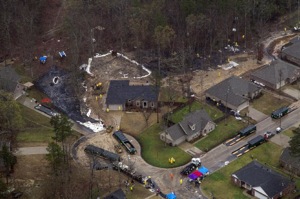MAYFLOWER - Retirement of Exxon Mobil’s more than-60-year-old crude-oil pipeline that ruptured in a Mayflower subdivision is “within the realm of possibilities,” a company vice president said Wednesday, shortly before a congressman released documents revealing that thousands of defects were found and repaired on the pipeline in 2010.

“I think it’s premature to come to judgment” on whether to close the Pegasus pipeline permanently, said Karen Tyrone, vice president for operations of Exxon Mobil Pipeline Co. “It is within the realm of possibilities and considerations.”
But until Exxon Mobil finishes its investigation of the March 29 spill in Mayflower, “we won’t know,” Tyrone told the Arkansas Democrat-Gazette during an interview in offices the company set up near Lake Conway shortly after the spill.
“Certainly we’re not going to restart the pipeline until it is safe to do so, and it is taking us some time to go through the investigation,” she added.
“I recognize people want answers, as do we, but we’re not going to rush the investigation. And until that’s done, we won’t know what the right thing to do with the pipeline is and exactly what’s required to ensure the integrity of that pipeline.”
“We are anxious to get the answers,” but such investigations take time, “often a year or more,” she said.
The Mayflower rupture - blamed in part on manufacturing defects called “hook cracks” - measured 22 feet long. It spilled an estimated 210,000 gallons of thick Canadian crude into the neighborhood, a ditch, an unnamed creek and a cove of Lake Conway.
Tyrone said pipeline inspections in 2010 and aimed at finding cracks and corrosion before an accident occurred had “found anomalies that we had to address, and they were addressed,” but the inspection found no problems in the pipeline segment that runs through the Northwoods subdivision of Mayflower.
Another in-line inspection conducted in February - less than two months before the Mayflower rupture on Good Friday - “didn’t immediately identify the defects” in the pipeline section either, she said. She said those results are still being studied.
The pipeline was made with a type of steel that federal regulators have warned for 25 years is prone to splitting along long, welded seams. Exxon Mobil must consider issues involving the Pegasus line’s electric-resistance-welded (ERW) pipe, Tyrone said, as well as the condition of the pipe overall and how the pipeline is operated.
Most of the pipeline, which runs about 850 miles from Illinois to the Gulf Coast of Texas, was built in 1947-48 by a now-defunct Youngstown, Ohio, company.
The segment of pipe that failed in Mayflower also tested as being extremely tough and brittle, she said. Such toughness, she said, is normally not seen, “even in this ERW pipe.”
“We have to look at all those things,” Tyrone said. “Not only that these are seam-welded, but everything we know about this pipe that impacts its integrity.”
Later Wednesday, U.S. Rep. Tim Griffin, a Republican whose 2nd District includes Mayflower, released two reports, one 630 pages and the other 120 pages, from the 2010 inspections commissioned by Exxon Mobil. It also appeared that a third 2010 document may be available, but Griffin’s office was unsure.
Exxon Mobil ran two inline inspections on the Pegasus pipeline in 2010, according to the federal Pipeline and Hazardous Materials Safety Administration. One was to test for metal loss on the entire line, and the other was to test for cracking on the northern section, according to the agency. The inspection earlier this year was to look for cracking in part of the line, it said.
The 120-page document released by Griffin summarized test results from the 142.68-mile pipeline stretch running from points controlled by the pipeline’s stations from Doniphan, Mo., to Conway. That report indicates that inspectors found five seam-weld defects and 5,510 metal-loss defects.
Of the 5,510 metal-loss defects, seven were “axial orientated seam weld metal loss and were classified as metal loss touching or crossing the seam weld.” The remaining 5,503 were manufacturing and metal-loss features in the pipe’s main body, the report said.
The five seam-weld defects were “not considered to be crack-like,” the report said. Rather, they displayed “some sort of seam weld abnormality. Many of these will have originated from the manufacturing process and will have been present in the pipeline since it was commissioned.”
The problems were not confined to one or two pipe segments.
“The seam weld defects and metal loss defects in this survey are distributed throughout the pipeline,” the report said. “Approximately 12 [percent] of the total number of spools contain a seam weld defect or a metal loss defect.”
The good news was that this inspection found “no metal loss or cracking associated with dents.”
The other 2010 report, totaling 630 pages, summarized test results from the 330.
4-milepipeline segment extending from areas under the Conway to Corsicana, Texas, stations. That report is far more technical than the first and includes numerous references to such things as “Long Seam Anomaly,” “Possible Non-Corrosion Anomaly,” “[Steel] Mill Anomaly,” “Girth Weld Anomaly” and “excess metal.”
At one point, the report said five anomalies met certain criteria and were reported to Exxon Mobil in a preliminary electronic report dated Aug. 23, 2010. The final report was not submitted until much later.The summary also indicated that the inspection found 4,726 reportable metal-loss features and three dents with metal-loss indications.
The federal administration redacted some information from the 2010 reports to remove certain geographical information for security reasons, Griffin said.
Griffin also released raw inspection data from an Arkansas portion of the February inspection, but those findings are not yet in narrative form and are highly technical. That test did include the Mayflower segment, Exxon Mobil spokesman David Eglinton said.
In a news release, Griffin said he believes that the inspection results “should be accessible to everyone.”
“While I am still going through the reports’ findings, I plan to cover all of this information with technical experts soon, and will continue to do everything I can to make sure the victims of this tragedy are made whole,” Griffin said.
Tyrone said inspection tools used in the industry have been constantly improving.
“The in-line inspection tools have gotten better,” she said. “I think the industry recognizes there is a need to identify potential issues and address them before they become problems. That is the whole intent of our integrity management program - to keep the pipe integrity intact. If there is a potential issue that can ultimately become a problem, we want to address it before it does. The tools detect more than they did before. We are using better tools than we have in the past, different tools than the past, consistent with [the] industry.”
The pipeline was being fully utilized when the accident occurred but will not be restarted until the company and the federal government are sure it’s safe to do so, Tyrone said.
Earlier Wednesday, Tyrone and another Exxon Mobil representative met in Little Rock with Gov. Mike Beebe.
Beebe spokesman Matt DeCample said the company had requested the approximately 30-minute visit to update the governor.
The governor repeatedly stressed during the meeting that he believes that Exxon Mobil should disclose all information such as the inspection reports, though he realizes that some things may need to be redacted for security reasons, DeCample said.
“He thinks everything should be released for everybody,” DeCample said. “He emphasized that repeatedly.”
Beebe’s other concern was about the older technology used in the pipeline and some others.
“While there is a nationwide infrastructure issue,” DeCample said, “when you know you have pipelines that … are using the before-70s-era [welded steel] … then there should be strong consideration to moving those away from watersheds.”
Among the watersheds through which the Pegasus pipeline passes in Arkansas is Lake Maumelle’s. That lake provides drinking water to more than 400,000 central Arkansans.
The Mayflower rupture forced long-term evacuations of 22 homes in the Northwoods subdivision. Most of those homeowners have not moved back, and Exxon Mobil has offered to buy the houses.
Of those houses and any others that Exxon Mobil buys, Tyrone said, “We’re going to manage the property in an organized fashion. We’re not going to dump a bunch of homes on the market.”
Front Section, Pages 1 on 08/15/2013

